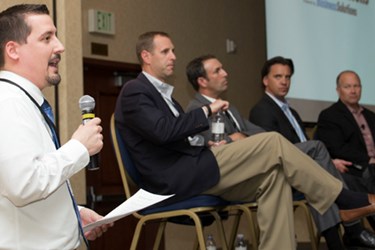Channel Transitions West: Established MSPs Give Advice On Funding The Transition To Managed Services


Practical advice on funding managed services was one of the topics the VAR/MSP Panel tackled at Channel Transitions West on April 29, the first of the 2014 Channel Transitions VAR/MSP Executive Conferences, powered by Business Solutions magazine. Members of the panel candidly shared their own stories of funding projects while transitioning to the as-a-Service business model from break-fix, as well as offering advice for managing finances during the transition and beyond.
Bruce Nelson, president of Vertical Solutions, a break-fix VAR who transitioned to managed services and to a 25 percent increase in profits, says his company “dove in head first.” After about six months of preparing to become a managed services provider (MSP), his company divided costs of projects over a specified timeframe — 3 months, 6 months, etc. — and used financing to augment cash flow. “You need to measure what the balance is of how quickly and effectively you can do it,” Nelson says. “It’s tricky. I’d probably take a little more of a conservative approach if I had to do it again.”
David DeCamillis, VP of sales and marketing for Platte River Networks, which transitioned a VAR business to as-a-Service model sparking double-digit annual sales growth, says his company started slow. They began offering only a few services — remote monitoring and management and antivirus and offsite backup — and began providing services to trusted customers who they knew would work with them as they embarked on the new model. DeCamillis says this approach didn’t have a big impact on cash flow, and it also took into account the time it would take their client base to adjust to the transition. “They weren’t used to paying for managed services. We had to learn how to show them that value,” DeCamillis explains. He describes the process as “tedious,” but adds, “We’re seeing huge success from it.”
Alex Rogers, CEO of ARRC Technology, says when his company first began the transition to Hardware-as-a-Service (HaaS), they simply divided the cost of the hardware by, for example, six months for the time to pay for upfront costs, and added $1,000 per month fee on top. “We were upside down for six months, and we did projects as we could afford them.” If his company couldn’t afford the costs, they proceeded with the standard service contract. Over time, the MSP found by taking into account services costs as well as the hardware, collecting one monthly payment and a setup fee at signing — and a month later collecting the next monthly payment and all the profits on the services — they saw two- to three-month ROI. He adds that money coming in “scales with right pricing and the number of users.”
Gary Pica stresses the importance of “right pricing.” His company, Dynamic Digital Services, became one of the fastest growing MSPs in the country, generating more than $500,000 of monthly recurring revenue. Pica’s company was acquired by mindSHIFT Technologies and he has since launched TruMethods, a coaching and mentoring company that has helped transform more than 800 IT providers around the world.
“You really have to know what your margins are on a per-seat, per-customer basis,” Pica says. He comments that one of the biggest mistakes he sees people making is collecting a monthly fee without taking margins into account, and then turning to a line of credit for cash. “But they can’t pay it down because they don’t have the additional margin they were hoping to get, and they haven’t figured it out,” Pica explains.
In addition to making sure you know your margins, he offers two more crucial pieces of advice:
- Consider both the services side and the capital side of your business. Consider whether it’s better to finance HaaS on your own or to use a third-party company for leasing.
- Don’t be held back by being undercapitalized. Recognize the difference between profit and cash flow — and make the best use of your cash. If you are often using a line of credit, consider converting it to long-term debt — and making smaller payments.
Pica recalls from his own transition to managed services, “By the time margins were right, we were able to fund everything. We had cash in the bank at all times.”
Channel Transitions is sponsored by: Platinum Sponsors GFI MAX and Mercury, Gold Sponsor F-Secure, along with industry association partners CompTIA, The ASCII Group, the Retail Solutions Providers Association (RSPA), and the Association for Automatic Identification and Mobility (AIM).
For more information on upcoming Channel Transitions VAR/MSP Executive Conferences, visit www.BSMinfo.com/go/ChannelTransitions.
